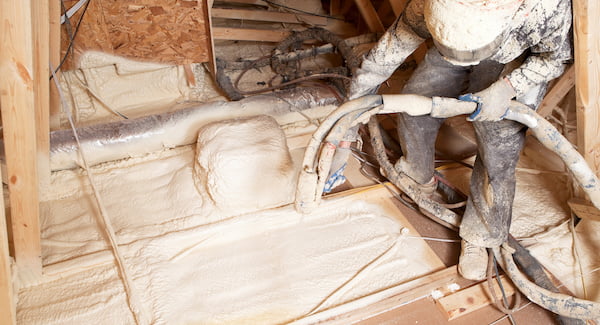Decades ago, closed-cell spray foam (ccSPF) insulation applied onsite was a very promising solution for improved building energy efficiency. Then scientists pointed out that the superb energy-saving properties were undermined by the huge global warming potential (GWP) due to the refrigerant used as a blowing agent in ccSPF. GWP ratings for the first generation of conventional spray foams ranged from about 700 to as high as 4,750, and many currently available spray foams are still close to 1,000. If you’ve been building or even contemplating zero energy homes as a direct form of climate action then using conventional two-pound spray foam takes several steps in the wrong direction. While many designers and builders now eschew spray foam because of this fatal flaw, others still use it extensively for other reasons. And now the good news: low GWP SPF is becoming available and some states are restricting the use of HFC blowing agents.
Benefits of ccSPF
It’s understandable that builders would have been attracted to these ccSPF materials. Although it may be more expensive per unit of installed R-value compared to other forms of insulation, it’s easy to specify in construction documents and has many energy-saving and moisture protection performance advantages. It packs more insulating value into an inch of thickness than almost any other material. It easily fills nooks and crannies. It blocks air movement and the passage of water vapor. It is impervious to liquid water, too, making it ideal for applications below grade and exterior locations with proper protections. Plus, ccSPF has structural properties that increase the shear strength of framed walls and bolster other structures, too.
New Products Offer the Advantages without the Disadvantages
With the world focused on global climate change, the refrigerant industry recently developed a new class of refrigerant called hydrofluoroolefins (HFOs) with a GWP below 5. HFO blowing agent is now available from Honeywell under the brand name Solstice. Several ccSPF manufacturers now use HFO blowing agents, including Huntsman Building Solutions, Carlisle, and GaCo, and they have been gaining in popularity and availability. Local insulation companies are beginning to provide the new HFO products and 16 states and all Canadian provinces have phased out or are beginning to phase out HFC products.
“We have a long history with spray foam and a strong commitment to high energy performance and to the environment,” said Doug Hansel-Pauly with Energy Conservation Insulation (ECI), “so we now offer a zero ozone depleting, low GWP spray foam from Gaco.”
ECI quotes a price of $1 per board foot (one square foot at one inch thick).
The price is still quite high compared to fiberglass or cellulose insulation, so most jobs are hybrid applications that take advantage of the unique properties of ccSPF while using as little as is needed to obtain those advantages.
For example, a hybrid wall system might be a 2×6 or 2×8 wood-framed wall with two inches of SPF and the remainder filled with fibrous insulation. Similarly, ccSPF can be used to create a conditioned attic with an unvented roof. In this case, from 3 to 4 inches of SPF are applied to the bottom of the roof sheathing depending on the climate. This prevents water vapor from reaching and then condensing on the sheathing. Additional insulation is installed below to reach the overall R-value desired. Another application places a thin layer of SPF on the attic side of a flat ceiling, which seals utility penetrations and top plates, with additional fibrous insulation above. Of course, before adopting any of these assemblies, be sure to confirm the moisture transfer dynamics for the climate to prevent condensation issues.
Pros and Cons
According to Hansel-Pauly, in addition to its low GWP, the Gaco foam offers a key advantage over previous products. It can be applied in layers up to 5.5 inches thick. This means a typical job can be completed in one pass as opposed to two, saving a lot of time and money.
In addition to the higher cost, even HFO-based ccSPF has other drawbacks.
- While it does reduce air leakage compared to fibrous insulation alone, it’s no magic bullet for super-tight construction. If the air leakage target is 3.0 air changes per hour at 50 pascals or lower, then additional measures will be needed.
- The blowing agent is still a complex, synthetic chemical and the resin is a petroleum derivative, although some products replace about 30% of the petrochemical with soy oil.
- Even though its GWP is low, some greenhouse gases are still released as it is applied. The trapped blowing agent also gradually escapes, emitting additional greenhouse gases and reducing the insulating value. For those designing a zero carbon home, the emissions from blowing agents should be factored into carbon calculations.
It’s likely that some construction teams will remain averse to ccSPF even with greatly improved GWP, while others will embrace it as an important step forward toward climate friendly construction.
Nevertheless, high-density ccSPF has gained a significant position in the construction industry because many builders and designers find the flaws to be worth the financial price and environmental tradeoffs. With this new crop of HFO-based spray foam products, one huge drawback has been removed, and ccSPF will find a place in the zero energy toolbox for some time to come. The takeaway for builders here is to be sure to ask your insulation installer for a low GWP spray foam as they are now readily available.

